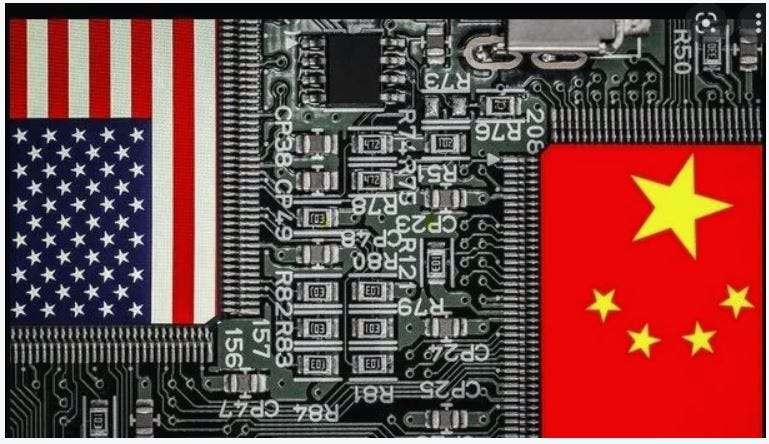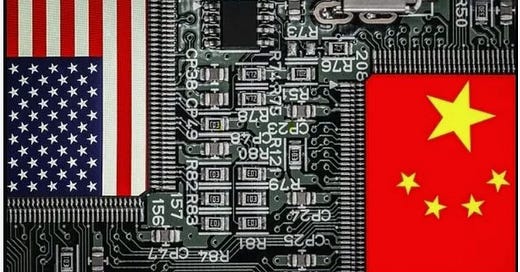Intel, China & Chips

If data is the new oil, then is Intel the new Exxon?
While we, the West, were caught by Putin in the game of economic geopolitics regarding energy supply, we won’t make the same mistake regarding semiconductor manufacturing and China. This time the Biden administration is ahead of the curve and has pushed through the Chips Act. This $280bn funding package is a rare bipartisan measure to support developing and producing high-end semiconductors on US soil, a large portion of which will fund Intel’s enormous new chip fab facility in (politically marginal) Ohio. Asia has eclipsed American supremacy in semiconductor manufacture to the point where it now threatens America’s National Security. Everyone agrees action is required.
Chips with everything.
For 25 years, from 1995, the US and, specifically, Intel dominated the world of semiconductor manufacturing. But as the PC gave way to other more specialist nodes on the internet, Intel’s star began to fade. ARM became unbeatable in low-power mobile applications, NVIDIA for games consoles and AMD for data centres. The Wintel relationship with Microsoft and the Intel Inside positioning was an epic land grab. However, the market for high-end semiconductors moved from the PC to new devices requiring different attributes. With its production-led culture and integrated design and manufacturing model, Intel couldn’t compete with smaller, more agile entrants.
The fab and the fabless.
Critically, Intel’s more innovative competitors grew alongside the emergence of TSMC (Taiwan Semiconductor Manufacturing Company). TSMC does what it says on the tin and exclusively specialises in manufacturing other peoples’ chip designs. The division of labour between the design and fabrication of silicon grew from customer demand for a wider variety of chips and faster innovation. Intel’s ability to remain a significant supplier has more to do with the resilience of the PC market than its ability to innovate. Indeed, at the sharp end of the highest-end production, Intel has slipped well behind TSMC and Samsung in fabrication and behind ARM, AMD, NVIDIA and others in specialist designs. In 2020 Jefferies analyst described Intel’s strategic predicament: “We think Intel extending its transistor cadence at the same time that TSMC accelerated to assume transistor leadership in 2018, stems from Intel’s decision in 2005 to not make chips for the iPhone. Since then, TSMC has benefitted from Learning Curve economies that come from serving a market that is 10x Intel’s. We think Intel continues to lose share to AMD and NVidia unless it figures out how to overcome TSMC’s learning curve advantage or moves to a fabless model”.
Globalisation 2.0.
As a result of this market dynamic, the world has grown increasingly dependent on Taiwan and South Korea for its high-end chip needs. But the geopolitical mood-music has changed. Secretary Yelland talks about the move from offshoring to friendshoring. Globalisation 1.0 is being upgraded, and few products are as dependent on complex global supply chains as semiconductors.
China supremacy.
Today’s accepted narrative is that after the anointment of Xi as Party Chairman for life this November, the dual circulation economic policy and the belt and road foreign policy will combine to allow the CPLA to walk into Tapei and annex Taiwan. China experts Stuart Paterson and Sam Olsen (What China Wants) believe China is on a war footing. If you think it is bad to be in hock to Putin for our natural gas requirements, imagine what it would be like to rely on China for our data processing and communications needs. The accepted conclusion is that we cannot allow the Chinese to invade Taiwan. It’s a compelling narrative. But it deserves scrutiny.
Made in Japan.
To be clear, we have been here before. In 1986, when China was still a closed agricultural peasant economy, six of the world’s top ten semiconductor producers were Japanese (today, there is only one left). The economic powerhouse in the East was Tokyo. Such was US concern about the success of post-war Japan that the Reagan administration proposed a deal with Japan to limit the import of semiconductors, followed a year later by a 100% tariff on Japanese chips and a $500m injection of state aid to the US industry. These measures did little to boost the leading US-based suppliers, TI and Motorola, but they successfully moved the international competition away from Japan. By 2005 only two Japanese suppliers were in the global top ten, well behind Samsung of South Korea and a new entrant with a novel model from Taiwan, TSMC.
Threat from the East.
By the late 1980s, the accepted inevitability was that Japan would eclipse the rest of the West to become its economic workhorse and financial master. Japan wasn’t going to use its technical and economic dominance militarily, but all the same, the US saw its decline in the chip market as a national security issue. Not only did Japanese companies dominate semiconductor manufacturing, but many other core industrial sectors as well as most areas of international finance. (In 1988, eight of the ten world’s biggest banks by asset bas were Japanese, with only Credit Agricole and Citicorp at nine and ten, respectively).
China has issues.
Today we have become accustomed to believing in the inevitability of eventual Chinese economic, financial and political supremacy. However, China’s path to becoming the world’s largest economy, most powerful military force and financial powerhouse is not inevitable. We misconstrue China in several critical ways. The first is regarding its technological prowess. Mainland China is a distant fifth in the league table of semiconductor production and doesn’t have a notable leader in the space. The US and the West (the EU is also subsidising new Intel fabs) are reacting to a lack of semiconductor competitiveness with Taiwan, not China.
Chips are difficult.
Furthermore, Taiwan’s world-beating fabs make leading-edge designs for agile fabless developers who are not mainly Chinese. China doesn’t have a version of Intel, let alone versions of NVIDIA, AMD, ARM or TSMC. China has developed its versions of America’s FAANGs which dominate in their domestic markets but has not succeeded in doing the complex engineering innovations demanded by hardware development. China depends upon Taiwan for its chips as much as we do.
Banking, politics and demography.
There is growing evidence that China’s financial system is creaking at the seams. It has an over-leveraged housing finance sector showing some early signs of stress not dissimilar to the 2007/8 period before Lehman’s demise. China’s political will is not as unified as we might imagine. It is hard to know, but it is not a foregone conclusion that Xi’s ascent to lifetime power will happen in November. China is also over-stretching itself abroad with its enormous belt and road investment portfolio showing signs of strain. Yet, the biggest structural problem facing China is its demographic time bomb. China is ageing rapidly and has a declining working population with little or no prospect of attracting immigration. Its inhumane and disastrous single-child policy (now in reversal) has permanently damaged China’s long-term productive capacity and competitiveness.
Invasion is not inevitable.
Of course, none of these issues means China will not invade Taiwan, and if it did, it would undoubtedly be a significant exogenous shock to the global economy. Yet we seem to have overestimated China’s strength. China faces real and profound risks and uncertainties, at least equal to the West.
Chinese politics are more subtle than Russia's.
Just because we underestimated the likelihood that Russia would invade Ukraine doesn’t mean China is more likely to invade Taiwan. Without a peace settlement, Russia looks set to become a resource-rich pariah state, excommunicated from the West but able to survive. Putin (and his successors) don’t require popular consent to rule as they have dependable energy revenues. China’s leaders, by contrast, must navigate a more subtle form of statecraft. While they don’t need a popular mandate, they require a social contract to deliver economic growth to their people. In short, Xi needs the West more than Putin needs the West. The dual circulation and belt and road policies aim to lessen China’s dependency on the West. However, cutting off access to Western markets for its exports would be too painful and politically risky.
Intel is hard to fix.
A reminder that Intel could do with some assistance came only an hour after passing the Chips Act when it revealed its 2022 Q2 results. They were not pretty reading. Indeed the update emphasised the perilous state of Intel, its dependency on declining PC sales, deteriorating financial position and a reminder of the herculean turnaround job facing its messianic CEO Pat Gelsinger. The Wall Street Journal put it: “As the largest domestic chip maker by both revenue and manufacturing footprint, Intel stands to benefit the most from legislation designed specifically to reduce reliance on overseas facilities for key technologies. But the company’s latest problems aren’t something even generous checks from Washington will fix. A slumping PC market has hurt demand for the type of processors that account for half of Intel’s revenue. Revenue in Intel’s client-computing division slid 25% year over year—its largest decline in at least eight years”.
Strategic dilemma.
Intel’s future has some interesting twists and turns ahead. The risk for Intel shareholders is that Biden’s Ohio pork barrel becomes a financial black hole if Taiwan remains independent and TSMC fulfils its planned aggressive investment programme. CEO Pat Gelsinger, an Intel veteran who won widespread recognition for the job he did in revitalising VMWare, sees himself, a born-again Christian, as the saviour of the West’s semiconductor manufacturing capability in the face of the imminent Chinese threat. Meanwhile, Mark Lapcis of Jefferies thinks the US government would get better value using its tax dollars to forge a US-based fab JV between TSMC and Intel.
Game theory of chips.
However it plays out, Intel’s financial future now looks assured, albeit not yet with an upward growth curve. Longer term, the picture is more binary. If China invades Taiwan, an investment in Intel offers insurance protection as global chip customers pivot West and into the arms of Intel. If Taiwan continues at peace and TSMC grows as planned, Intel struggles. The world will have excess supply, and Intel’s future could look much like a continuation of the uphill struggle of the last few years.
Jeremy
Ealing
The post Intel, China & Chips appeared first on Progressive.



